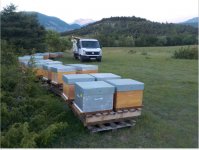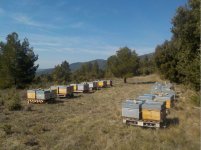Hi everyone,
This is my first thread, so please be nice, and sorry if my english is not on point.
I'm a commercial beekeeper located in the south of the French alps, near Provence ( between Grenoble and Marseille, for those who knew a little bit of France's geography)
I'm 29 years old and owned more or less 250 hives ( which is a little/medium size of beekeeping farm here ). I ve started my own compagny 4 years ago, and for the past ten years, i worked on different farms around the country.
In the south of France, there is both users of langstroth and dadant hives. Personnaly I use Dadant hives with 10 frames . Mostly, we use 1/2 dadant box has a honey chamber.

There is different honey flow trough the season that we try to reach. In march, the beginning of spring, i move my hives on "scrubland", a semi desertic mediterannean type of land wich we call " garrigues". In those type of places, it is possible to make Rosemary honey, and rarely thyme honey.
Then, we have the choice of moving hives on north, trying to make acacia honey, or we can move to the mountains meadows.
In june, we make chestnut honey, and just after that, take place the last and the most important honey flow of the season, the most emblematic honey of our region, the lavender honey.
Chestnut blooming

Lavender field on the Valensole Plateau

For breeding, i have 1/2 dadant frame type of nucleus, called "haussettes". I mostly work with buckfast type of bees, every year I buy F0 queens to commercial breeders in Germany and Holland mostly.

To move hives, I work with a spanish crane (apijuneda), that is veru useful, and my truck is a volkswagen Crafter ( 3.5 T)

Than you very much, if you have any questions or commentary about beekeeping in France, I will try to respond on anything i can.
Sorry in advance if I ask obvious questions about beekeeping in NZ but i'm curious and there is plenty of things I don't know about.
This is my first thread, so please be nice, and sorry if my english is not on point.
I'm a commercial beekeeper located in the south of the French alps, near Provence ( between Grenoble and Marseille, for those who knew a little bit of France's geography)
I'm 29 years old and owned more or less 250 hives ( which is a little/medium size of beekeeping farm here ). I ve started my own compagny 4 years ago, and for the past ten years, i worked on different farms around the country.
In the south of France, there is both users of langstroth and dadant hives. Personnaly I use Dadant hives with 10 frames . Mostly, we use 1/2 dadant box has a honey chamber.

There is different honey flow trough the season that we try to reach. In march, the beginning of spring, i move my hives on "scrubland", a semi desertic mediterannean type of land wich we call " garrigues". In those type of places, it is possible to make Rosemary honey, and rarely thyme honey.
Then, we have the choice of moving hives on north, trying to make acacia honey, or we can move to the mountains meadows.
In june, we make chestnut honey, and just after that, take place the last and the most important honey flow of the season, the most emblematic honey of our region, the lavender honey.
Chestnut blooming

Lavender field on the Valensole Plateau

For breeding, i have 1/2 dadant frame type of nucleus, called "haussettes". I mostly work with buckfast type of bees, every year I buy F0 queens to commercial breeders in Germany and Holland mostly.

To move hives, I work with a spanish crane (apijuneda), that is veru useful, and my truck is a volkswagen Crafter ( 3.5 T)

Than you very much, if you have any questions or commentary about beekeeping in France, I will try to respond on anything i can.
Sorry in advance if I ask obvious questions about beekeeping in NZ but i'm curious and there is plenty of things I don't know about.
Last edited by a moderator:










